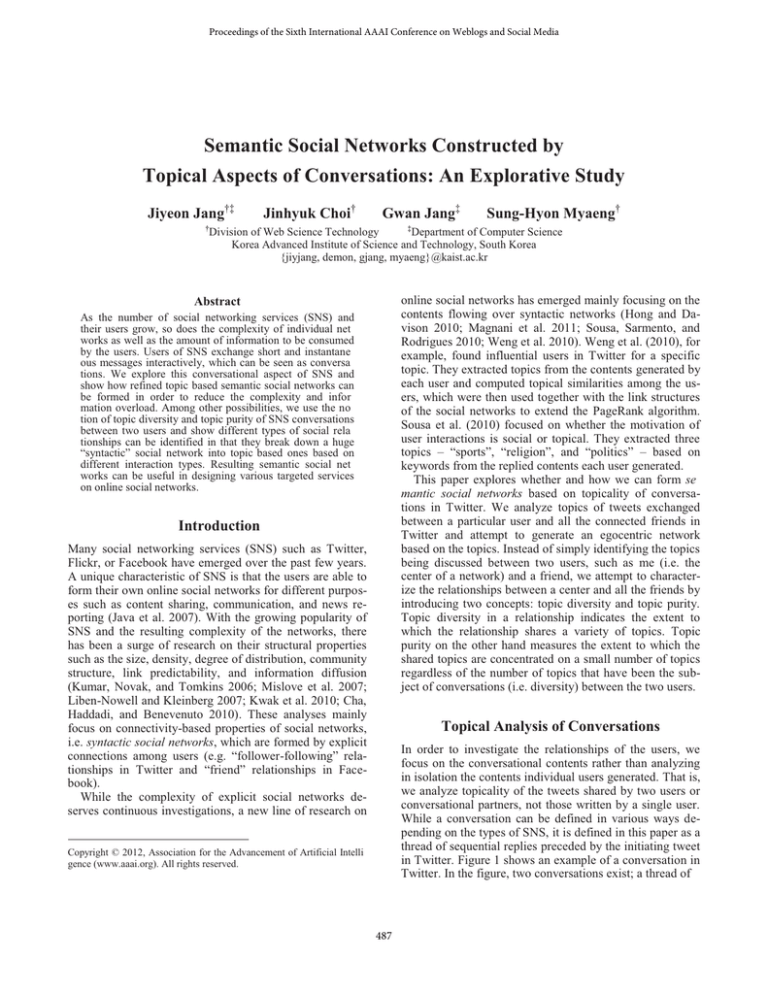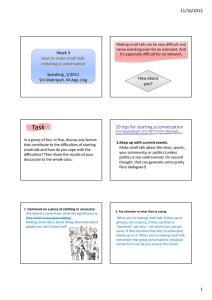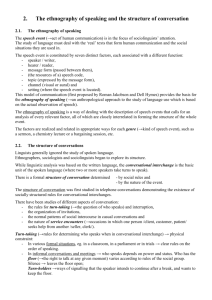
Proceedings of the Sixth International AAAI Conference on Weblogs and Social Media
Semantic Social Networks Constructed by
Topical Aspects of Conversations: An Explorative Study
Jiyeon Jang†‡
Jinhyuk Choi†
Gwan Jang‡
Sung-Hyon Myaeng†
†
‡
Division of Web Science Technology
Department of Computer Science
Korea Advanced Institute of Science and Technology, South Korea
{jiyjang, demon, gjang, myaeng}@kaist.ac.kr
online social networks has emerged mainly focusing on the
contents flowing over syntactic networks (Hong and Davison 2010; Magnani et al. 2011; Sousa, Sarmento, and
Rodrigues 2010; Weng et al. 2010). Weng et al. (2010), for
example, found influential users in Twitter for a specific
topic. They extracted topics from the contents generated by
each user and computed topical similarities among the users, which were then used together with the link structures
of the social networks to extend the PageRank algorithm.
Sousa et al. (2010) focused on whether the motivation of
user interactions is social or topical. They extracted three
topics – “sports”, “religion”, and “politics” – based on
keywords from the replied contents each user generated.
This paper explores whether and how we can form se
mantic social networks based on topicality of conversations in Twitter. We analyze topics of tweets exchanged
between a particular user and all the connected friends in
Twitter and attempt to generate an egocentric network
based on the topics. Instead of simply identifying the topics
being discussed between two users, such as me (i.e. the
center of a network) and a friend, we attempt to characterize the relationships between a center and all the friends by
introducing two concepts: topic diversity and topic purity.
Topic diversity in a relationship indicates the extent to
which the relationship shares a variety of topics. Topic
purity on the other hand measures the extent to which the
shared topics are concentrated on a small number of topics
regardless of the number of topics that have been the subject of conversations (i.e. diversity) between the two users.
Abstract
As the number of social networking services (SNS) and
their users grow, so does the complexity of individual net
works as well as the amount of information to be consumed
by the users. Users of SNS exchange short and instantane
ous messages interactively, which can be seen as conversa
tions. We explore this conversational aspect of SNS and
show how refined topic based semantic social networks can
be formed in order to reduce the complexity and infor
mation overload. Among other possibilities, we use the no
tion of topic diversity and topic purity of SNS conversations
between two users and show different types of social rela
tionships can be identified in that they break down a huge
“syntactic” social network into topic based ones based on
different interaction types. Resulting semantic social net
works can be useful in designing various targeted services
on online social networks.
Introduction
Many social networking services (SNS) such as Twitter,
Flickr, or Facebook have emerged over the past few years.
A unique characteristic of SNS is that the users are able to
form their own online social networks for different purposes such as content sharing, communication, and news reporting (Java et al. 2007). With the growing popularity of
SNS and the resulting complexity of the networks, there
has been a surge of research on their structural properties
such as the size, density, degree of distribution, community
structure, link predictability, and information diffusion
(Kumar, Novak, and Tomkins 2006; Mislove et al. 2007;
Liben-Nowell and Kleinberg 2007; Kwak et al. 2010; Cha,
Haddadi, and Benevenuto 2010). These analyses mainly
focus on connectivity-based properties of social networks,
i.e. syntactic social networks, which are formed by explicit
connections among users (e.g. “follower-following” relationships in Twitter and “friend” relationships in Facebook).
While the complexity of explicit social networks deserves continuous investigations, a new line of research on
Topical Analysis of Conversations
In order to investigate the relationships of the users, we
focus on the conversational contents rather than analyzing
in isolation the contents individual users generated. That is,
we analyze topicality of the tweets shared by two users or
conversational partners, not those written by a single user.
While a conversation can be defined in various ways depending on the types of SNS, it is defined in this paper as a
thread of sequential replies preceded by the initiating tweet
in Twitter. Figure 1 shows an example of a conversation in
Twitter. In the figure, two conversations exist; a thread of
Copyright © 2012, Association for the Advancement of Artificial Intelli
gence (www.aaai.org). All rights reserved.
487
UserA
There’s WAY too much attention on
AOL and Yahoo right now. Successful
mergers get done quietly, in the dark.
Not in this kind of glare.
@UserB I do that all the time lol
@UserB American Public media and
Minnesota Public Radio?
Topic diversity (TD) in a relationship is introduced as a
way of measuring the degree to which a relationship shares
a wide range of topics. A high TD value means the two
users conversed over many different topics. A low value
means their conversations stayed in more or less coherent
topics. TD can be measured in terms of similarity among
the topics for a relationship. In our framework, topical similarity can be computed using topic-word matrix which
consists of word distributions for individual topics identified. Among several similarity metrics we can choose from,
we opted for JS Divergence because it has been commonly
used for topical similarity measurement for its superiority
(Blei, Ng, and Jordan 2003; Weng et al. 2010; Kim and Oh
2011).
Topic distance matrix of a user can be constructed by
calculating topic dissimilarities among all topics identified
for a relationship as follows:
UserB
I am so mad that I just gt out the bed
and fell STRAIGHT to the ground.
TOO sore right now… LOL
@UserA wait. What successful
mergers have been “done quietly, in
the dark”? Better yet, what are some
successful mergers?
@UserA how do u gt rid of
soreness???
Figure 1: An example of a conversation.
white boxes and that of gray boxes. Note that a conversational partner of User A is User B and vice versa.
To identify topics for all the relationships centered
around a user, we use Latent Dirichlet Allocation (LDA),
which is a commonly used method for topic modeling
(Blei, Ng, and Jordan 2003; Griffiths and Steyvers 2004;
Steyvers and Griffiths 2007). LDA models each document
(i.e. conversation in this work) as a mixture of topics, each
of which is represented as a probability distribution over
words, and each word is treated as chosen from a single
topic. In LDA, a word document co-occurrence matrix can
be decomposed into two parts; document-topic matrix and
topic-word matrix. We set hyper-parameters and to 0.1
and 0.01, respectively, which were commonly used in the
past (Kim and Oh 2011). The number of topics we extract
is 100.
Document Topic Matrix for a user shows topic distributions of all the conversations the user has shared with others since we regard one conversation as one document. If
two users share only one conversation, the relationship has
only one topic distribution; otherwise, it has multiple topic
distributions. Topic Word Matrix shows a word distribution in each topic and hence can be used to compute similarities among topics.
Given a conversation (document)-topic matrix for a user,
which contains a topic distribution for each conversation,
we can represent each conversation as follows:
where K is the number of topics,
represents the topic
dissimilarity between two topics and , and
is calcuwhere
lated as
and
. KL stands for
KL Divergence.
Topic diversity should be high when dissimilar a variety
of topics are strongly represented in topic distribution. As
and
to form a
such, we multiply
vector where each element indicates how strong the corresponding topic is in comparison with other topics. Topic
diversity can be measured by taking an average of the disof a
tinctiveness of individual topics.
relationship between two users can be computed as:
,
where
is an average value of elements of a vector.
Topic purity indicates the tendency that a relationship
(the conversations carried out by two users) focuses on
specific topics. If two users exchanged tweets on a single
topic such as local politics only, for example, their topic
purity is maximal. Even if they talked about many different
topics occasionally, their topic purity would be quite high
if they tended to elaborate on a particular topic more frequently. The more uniform a topic distribution, the lower
topic purity. Note that a relationship may have higher purity even with a greater number of salient topics than another
with less number of topics. It is entirely possible for a relationship with higher topic diversity to have higher purity
than others with lower topic diversity.
Since the topic purity detects whether there are a small
number of outstanding topics, we chose a simple method of
taking the maximum value of elements in MTD. This is
because our interest is to identify a relationship that has an
outstanding topic. Given that the sum of all the probability
values in MTD is 1, it is sufficient to use the maximum
is a probability of
where K is the number of topics and
topic of conversation . When there are multiple conversations for a relationship, we compute a composite topic
distribution that embraces all the topic distributions for the
purpose of understanding the topics covered between the
, of a
two users. Mixture of topic distributions,
relationship between two users, a user and a conversational partner , is computed as follows:
where N is the total number of conversations in the relationship, K is the number of topics, is probability of
topic of conversation j, and
is the length of conversation j, which is the number of tweets in each conversation.
Since the number of characters is limited in a tweet, it
makes sense to use the number of tweets as an important
factor as it indicates how eagerly two users were engaged
in a conversation.
488
probability value of the outstanding topic to represent topic
of a relationship between
purity. Thus,
two users can be calculated as:
where
, K is the number of topics, and
.
Analysis of Semantic Social Networks
Figure 2: Distribution of topical social relationships.
Dataset
es of 0.76 and 0.78 in topic diversity and 0.19 and 0.25 in
topic purity, which hardly show tendencies, account for
about 40% of all relationships. The rest can be divided into
four categories: 24% of the relationships have a tendency
toward high diversity and high purity, 17% toward high
diversity and low purity, 13% toward low diversity and
low purity, and 7% toward low diversity and high purity.
This analysis suggests that about a half of the relationships
can be categorized by patterns of diversity and purity combinations although the majority of the conversational relationships tend to talk about diverse topics without a small
number of salient, concentrated topics. It is encouraging,
however, to observe that a quite large number of relationships have high purity and carries out conversations with a
focus.
To get a sense of the characteristics of the relationships
belonging to each of the four categories, we select one
sample for each and illustrate what the topic distributions
look like as in Figure 3. Note that the four samples are
chosen in such a way that the numbers of conversations
and tweets are almost the same across the four cases. We
can recognize the high diversity relationships on the right
have more peaks than those on the left. High purity relationships in the upper row, on the other hand, have higher
peaks than those in the lower row. Reciprocally, the graph
patterns indicate that the two measures, diversity and purity of a topic, seem appropriate in characterizing conversational relationships.
We chose Twitter to collect the conversational data. To
detect conversations, we used the “Reply” options although
Twitter allows users to react to tweets of other users by
“Favorite” and “Retweet” as well as “Reply”.
To collect our dataset, we first randomly sampled 2,036
users who use English, have more than 3,200 1 tweets in
total, and have at least one conversation between September 9th, 2011 and October 4th, 2011. We then collected all
the conversations they were engaged in. In order to track
all the conversations of the users, we identified the tweets
that were replied to some other tweets. We repeatedly followed the chain of replies to recover the complete set of
conversations. After collecting all the conversations, we
duplicated a conversation into multiple copies if more than
two users were involved in it so that each conversation in
our dataset has only two users.
In order to ensure we had enough data for topic extraction, we identified the users with more than 400 conversations, removed the conversations whose length is less than
2 tweets, and removed special characters and stop words.
Consequently, our dataset contains 1,414 users with their
263,638 unique conversational partners, and 1,338,002
conversations including 4,582,461 tweets in total.
Characterizing Topic-based Relationships
as follows:
Semantic vs. Syntactic Social Networks
A semantic social relationship exists between a user ( )
and a conversational partner ( ). Each relationship has its
topic distribution vector by computed MTD, topic diver, and topic purity
. In the current experiment,
sity
each user pair has 100 topic-specific relationships since
contains a topic probability for each topic of 100 topics
that were extracted in this study.
We first analyzed the overall trend of all the relationships in terms of their topic diversity and purity values. In
Figure 2 where topic diversity and purity values for relationships are plotted, we can see that the relationships lean
toward high diversity and low purity since the median values of topic diversity and purity values are about 0.77 and
0.22, respectively. Moreover, the relationships in the rang-
The main differences between semantic and syntactic social networks lie in the size and richness of the relationships. The size of a social network can be reduced simply
by considering whether a relationship is purely based on
following-follower connections or based on conversational
relationships, the types of interactions based on topic diveDiversity
03
0 25
02
0 15
01
0 05
0
1 10 19 28 37 46 55 64 73 82 91 100
High
Topic Probability
High
Purity
Topic Probability
Low
03
0 25
02
0 15
01
0 05
0
1 10 19 28 37 46 55 64 73 82 91 100
03
0 25
02
0 15
01
0 05
0
1 10 19 28 37 46 55 64 73 82 91 100
Topic
Topic
Topic Probability
Low
Topic
Topic Probability
We define a semantic social relationship
03
0 25
02
0 15
01
0 05
0
1 10 19 28 37 46 55 64 73 82 91 100
Topic
Figure 3: Topic distributions for a sample of relationships for
different categories.
1
Twitter API limits that the maximum number of tweets to show is 3,200
even if a user wrote more than 3,200 tweets
489
(a)
(b)
him/her happy by delivering the contents from the people
whose profile matches.
There are several avenues we plan to explore for future
research. We are going to investigate user patterns based
on their relationships, include other interactions such as
retweets and favorites, and analyze temporal aspects of
topics since user interests would change over time. Also, a
natural extension to the current framework targeted at egocentric networks is to integrate individual networks to
build general semantic social networks that include a group
of people. Another direction is to compare and combine
syntactic and semantic social networks for a synergy (Li et
al. 2011). Still another avenue to explore is a variety of
applications that can be made possible by using semantic
social networks.
(c)
Figure 4: Different networks created for a user and the partners depending on the number of topics considered.
rsity and purity, and a particular topic.
The biggest advantage of semantic social network comes
from the fact that we can identify sub-networks by selecting topics on relationships and the types of relationships.
Figure 4 (a) shows a network of conversational partners on
a particular topic2 with high diversity and high purity relationships. At the center is the node for the user who is connected to about 20 conversational partners by an edge. The
thickness of an edge indicates intensity of the topic in conversations with the partner. As topics are added, the network becomes denser as can be seen in (b). Since a relationship between the user and a particular partner can have
up to 100 edges corresponding to the maximum number of
topics in our current analyses, the network becomes much
more complex when no topic selection is done. The ‘core’
at the center in Figure 4 (c) represents all the partners,
which are heavily concentrated in a small region while
each spike means a topic-labeled arc that links the user and
a partner. Since there can be up to 100 links between the
user and a partner, the visualization package 3 we used
show them this way.
Acknowledgments This research was supported by WCU
(World Class University) program under the National Research Foundation of Korea and funded by the Ministry of
Education, Science and Technology of Korea (Project No:
R31-30007)
References
Blei, D. M., Ng, A. Y., and Jordan, M. I. 2003. Latent Dirichlet Alloca
tion, Journal of Machine Learning Research, v.3, 993 1022.
Cha, M., Haddadi, H , and Benevenuto, F. 2010. Measuring User Influ
ence in Twitter: The Million Follower Fallacy, Proc. ICWSM.
Griffiths, T. L. and Steyvers, M. 2004. Finding Scientific Topics, Pro
ceedings of the National Academy of Sciences, v.101, 5228 5235.
Hong, L. and Davison, B. D. 2010. Empirical study of topic modeling in
Twitter, Proc. 1st Workshop on Social Media Analytics (SOMA).
Java, A., Song, X., Finin, T., and Tseng, B. 2007. Why We Twitter: Un
derstanding Microblogging Usage and Communities. Proc. Web
KDD/SNA KDD.
Kim, D. and Oh, A. 2011. Topic Chains for Understanding a News Cor
pus, Proc. CICLING.
Kumar, R., Novak, J., and Tomkins, A. 2006. Structure and Evolution of
Online Social Networks. Proc. KDD.
Kwak, H., Lee, C., Park, H., and Moon, S. 2010. What is Twitter, a Social
Network or a News Media? Proc. WWW.
Li, D., Ding, Y., Sugimoto, C., He, B., Tang, J., Yan, E., Lin, N., Qin, Z.,
and Dong, T. 2011. Modeling Topic and Community Structure in Social
Tagging: the TTR LDA Community Model, JASIST, 62(9), 1849 1866.
Liben Nowell, D. and Kleinberg, J. 2007. The link prediction problem for
social networks, Journal of the American Society for Information Science
and Technology, 58(7), p.1019 1031.
Magnani, M., Montesi, D., Nunziante, G., and Rossi, L. 2011. Conversa
tion Retrieval from Twitter, Proc. ECIR.
Mislove, A., Marcon, M., Gummadi, K. P., Druschel, P., and Bhattachar
jee, B. 2007. Measurement and and Analysis of Online Social Networks,
Proc. IMC.
Sousa, D., Sarmento, L., and Rodrigues, E. M. 2010. Characterization of
the Twitter @replies Network: Are User Ties Social or Topical? Proc.
SMUC.
Steyvers, M. and Griffiths, T. L. 2007. Probabilistic Topic Models, T.
Landauer, D. McNamara, S. Dennis, and W. Kintesch, editors, Latent
Semantic Analysis: A Road to Meaning. Laurence Erlbaum, In Press.
Weng, J., Lim, E. P, Jiang, J., and He, Q. 2010. Twitter Rank: finding
topic sensitive influential twitterers, Proc. WSDM.
Discussion
Our study is on discovering and exploring a new type of
social networks – semantic social networks – based on
topical aspects of conversations between a user and each of
her partners. In order to characterize different types of topical interactions, we introduced the notions of topic diversity and topic purity that can be computed for individual
relationships. Using these measures, social relationships of
users can be characterized in terms of their conversational
behaviors or styles in online interactions with the “friends”.
The resulting social networks can be used in various
applications. For example, the patterns of the topical interactions identified for individual users can be used to filter
out or recommend contents in SNS. This kind of service
can be refined further by understanding how diverse or
pure the past interactions have been. For the users showing
high diversity in the relationships, for example, the service
may not want to adhere to the history of the topics covered
in the conversations so much. On the other hand, if a user
shows high purity in the relationships, it is likely to make
2
The topic in this figure is on ‘finance’, which is actually represented by
a set of words {banks, allessio, rastani, financial, loans}.
3
http://jung.sourceforge.net. JUNG
490





